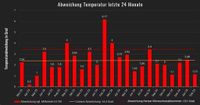As spring ushers in milder weather across Germany, a dramatic shift in conditions is on the horizon. Meteorologists are identifying a transition from sunny, mild days to a forecast of colder air, rain, and even the possibility of snow as March reaches its conclusion. Initially, temperatures are expected to peak between 20 and 24 degrees Celsius, providing what many are enjoying as the first taste of spring warmth.
On Friday, March 21, 2025, meteorologists predict particularly pleasant conditions, with sunny skies over much of the country. Inevitably, however, caution looms as weather expert Dominik Jung warns that "in the east and south should remain sunny, but Sahara dust could cloud the sky in the west." This dust, coming from the Sahara, could obscure the view, creating a milky haze that may dampen the otherwise cheerful spring prospects.
The warm weather witnessed in Germany is largely a result of high-pressure systems sweeping over the region. These systems have brought discovery-like temperatures, causing a sense of optimism among outdoor enthusiasts. According to Jung, areas in the west and south may warm up to 24 degrees Celsius on Friday, leading to enjoyment in parks and open spaces.
However, the serenity of spring is soon to be disrupted. As we approach the last week of March, a significant weather shift is anticipated, influenced by the arrival of polar air masses along with rain. Jung highlights the European weather model ECMWF, which indicates a considerable downturn in weather patterns. A transition marked by increasing cloud cover and potential precipitation is expected to introduce rainy conditions throughout the last seven days of the month.
From Saturday, March 22, the cloudy weather will set in—particularly south of a line drawn from Münster to Berlin—where showers accompanied by thunderstorms are anticipated. The warm daze of the previous days would give way to daytime highs falling between 10 to 14 degrees Celsius in many places. Such temperatures fit the averages for late March, signaling an abrupt emotional shift for those who have enjoyed the preceding warmth.
The influx of polar air will increase the likelihood of snow, particularly in higher altitudes. Jung notes, "It’s important to remain cautious about tire changes due to the risk of black ice in higher altitudes," emphasizing that slick conditions may arise overnight, as temperature drops could create hazardous driving conditions. This change aiming to affect both casual travelers and those in remote regions should not be underestimated.
Weather forecasts are clear: the beginning of April heralds its own uncertainties. Local weather services anticipate that the March will be characterized as surprisingly dry despite the incoming shifts. Rainfall predictions earlier in the month suggested otherwise, yet recent models no longer indicate extensive rain events, leaving some regions yearning for moisture. Vital to the agricultural community, the dry trend remains concerning, necessitating sustained attention to water levels and soil conditions.
As winter refuses to release its grip entirely, those who’ve enjoyed the warmth may soon need to prepare for another round of jacket weather. The fluctuations typical of March in Germany are expected, but predictions imply that by April, a return to stabilizing temperatures could surface. Yet until that moment comes, the climate will stay finicky, exhibiting its propensity for surprises and unpredictability.
Individuals in cooler areas, especially in the mountains, have been advised to postpone changing over to summer tires, as icy conditions could make roads treacherous. Jung warns that this unpredictable cycle is likely to bring not only cold air but also sporadic snow events that may occur in the coming weeks. "The nature needs rain, yet receipts of it may coincide with winter-like temperatures, leading to discomfort for many, especially as conditions turn wet and icy," he adds.
The long-term forecast for early April looks more promising, with indications that more consistent spring weather could arise, but until then, maintain a watchful eye on changing forecasts. The fluctuations expected across Germany highlight the challenges nature often brings as its transitions unfold, reminding everyone to stay prepared—both for warm sunshine and frosty surprises.





